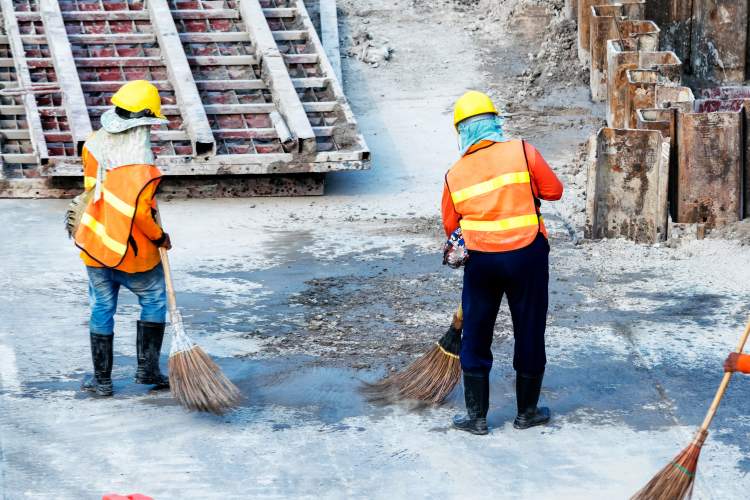Request for Information documents (RFIs) are commonly used by contractors in the construction process. This guide provides a brief overview of the RFI’s purpose, application, process and content – and also includes a handy list of best practices to follow.
Table of Contents
What is the Purpose of an RFI in Construction?
The RFI plays an essential role in construction communication on a project. The purpose of an RFI document is to facilitate the asking and answering of a specific question regarding an agreement, plan, drawing or specification. The question may address an information gap, ambiguous wording, or a certain issue that requires some sort of resolution both before or during a construction project.
RFIs also present an opportunity for subcontractors to propose solutions to the issues they’re calling attention to. In this respect, RFIs can serve as a kind of value-add for both the sub and the GC. The sub gets to demonstrate their proactivity and attention to detail, while the GC gains more confidence in the subs they’ve hired to do the work and knows that issues/errors are being addressed, as well as gaps in the specs are being addressed.
Getting an answer to every question is important during the pre-construction stage to help prevent confusion, misunderstandings and errors. This helps minimize the need for time-consuming, costly corrective measures later on, during the construction phase.
Therefore, it’s important to note that you should never hesitate to submit an RFI when something is not clear. The use of RFI documents in the construction industry is commonplace, and both expected and accepted. RFIs can sometimes result in change orders.
Common Scenarios That Result in an RFI
Contractors typically submit RFIs for the following reasons:
-
- Additional information or clarification is needed – For example: The model of framing hardware wasn’t noted by the engineer; A critical dimension between gridlines is not called out on plan; The steel beam called out on plan isn’t manufactured any longer.
- Wanting to propose a substitution or a modification – For example: A more cost effective model of framing hardware is proposed in lieu of what’s noted on plan; A different model of an RTU is available has a shorter lead time.
- Having to call attention to a construction concern, error or deficiency – For example: The retrofit concrete footing detail isn’t constructable as drawn; The wood beam is too deep and conflicts with the drywall ceiling; The plans aren’t up to ADA requirements.
How Does the Construction RFI Process Work?
Drafting and submitting an RFI is a formal written process that must be done correctly in order to be effective. Contractors issue RFIs both at the beginning of a project and during it. It is a periodic process, as issues and problems can arise at any point in the process.
You can send an RFI to an architect, engineer or other qualified consultant who is in a position to respond with appropriate answers. If the answer to an RFI is found to be insufficient, you can then resubmit it or request a meeting to seek further clarification.
What to Include in a Construction RFI
Draft every RFI so that it is concise, well organized and easy to understand. Format the content in a professional manner, express your question clearly, and add contextual information (such as photographs) when necessary, to enhance clarity. This will help minimize confusion and back-and-forth communication to ensure that you get a timely response.
Typically, you will want to include the following information in your draft:
- Your contact information (name, title, company, phone, email)
- The responding party’s contact information (name, title, company, phone, email)
- Project name/location/description
- RFI number (in sequential order, if you are submitting multiple RFIs for that particular project)
- RFI title and a brief description
- RFI submission date
- Date (deadline) when you require a response
- Description of your request
- Reason for your request
- A suggestion for resolution, if applicable
- A list of attachments, if applicable
- References to any other relevant plans, drawings or specifications, if applicable
While this list is not exhaustive, it does represent the most critical information that should be incorporated.
Best Practices for Submitting and Dealing With RFIs in Construction
How you handle construction RFIs can have a considerable impact on your project outcomes. Follow these tips to manage the RFI process effectively for every new project:
- Study your project contract thoroughly as soon as you receive it. This will allow you to identify missing information or foreseeable issues, so that you can formulate RFIs right away.
- Consider the cost of each RFI to all parties involved. This is especially applicable when you want to propose a substitution or a modification that may drive up the project’s overall cost.
- Dedicate a point person to manage it. This individual should be recognized as the “owner” of the RFI process. However, you also should make sure your entire team understands, appreciates and supports RFI development. Every employee has a stake in using RFIs properly.
- Use a standardized form for your RFI documents. This will help speed up the RFI drafting process.
- Follow the RFI instructions in your project contract. That document may specify how to format your RFI, the timeframe for submitting it, and the time you should allow to receive a response.
- Limit each RFI to just one issue or topic. This makes it much easier for the recipient to respond.
- Use language that is clear, concise and specific. Avoid long, rambling paragraphs and use of unnecessary details.
- Keep the tone courteous and professional. This helps build a good rapport.
- Reference past RFIs your company created for similar projects. These may serve as helpful resources.
- If you are submitting multiple RFIs, assign a priority to each one. Then number those in the proper sequence for tracking purposes.
- Remember to add all supporting documentation. That may include plans, drawings, specifications or photos.
- Submit RFIs early, without delay. You want to get a response sooner rather than later, to avoid any improper work or costly interruptions during the construction phase.
- If you do not receive a timely response, follow up with the RFI recipient. This is perfectly acceptable – especially if the topic must be addressed urgently.
- Make sure your point person records all responses that are received. This is important for documentation purposes. Also, each RFI should be closed after it is answered in a satisfactory manner.
- Use cloud-based construction software to manage RFIs. This is particularly important when multiple employees need to be involved with the RFI drafting, tracking and approval process. A cloud platform will allow greater visibility and access to all related information, thereby enhancing collaboration and productivity. It will allow you to automate a workflow for the RFI process, one that eliminates reliance on hit-or-miss email correspondence. It will ensure that all stakeholders are working with the latest RFI draft. Plus, it will allow all completed RFIs to be logged and stored in one central location, to serve as helpful resources for future projects. This also ensures that you have a permanent RFI audit trail, which may be essential when dealing with any potential claims pertaining to negligence or fraud.
- Adjust your project schedule and budget, if necessary, after receiving an RFI response. The response you receive will require your immediate attention, so be sure to carve out time to review and react to it.
Key Takeaways for Contractors
When used correctly, the RFI is a beneficial tool for gathering additional input and achieving greater clarity throughout the project. By understanding the RFI’s purpose and applications and engaging in best practices, you and your staff can kick off new projects with greater confidence!








